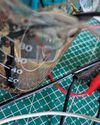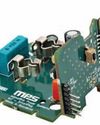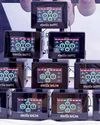Why Industries Are Shifting FROM SILICON TO SILICON CARBIDE For Power Electronics
Electronics For You
|July 2024
Silicon carbide (SiC) revolutionises power semiconductors, cutting switching losses by up to 90% and enhancing efficiency and compactness. As demand for electric mobility and sustainable energy grows, SiC drives a greener, more efficient future.
With its enhanced efficiency and durability, SiC is not just a material; it’s the cornerstone of sustainable technological progress. It improves the overall performance of electronic components, positioning itself as a critical element in the future of high-power applications.
A webinar hosted by Diotec and IBS Electronics highlighted SiC’s advantages over traditional silicon in applications like EV chargers and solar inverters.
SiC technology is revolutionising various sectors with its capabilities in high voltage and high frequency switching applications, which are essential for electric vehicle charging and solar inverters. Discussions on the latest SiC MOSFETs and Schottky diodes demonstrated their significant impact on efficiency and performance, making SiC a pivotal element in the future of power electronics.
Silicon carbide is more expensive than traditional silicon, yet for many manufacturers, its benefits far outweigh the cost. With an electrical breakdown field of 2.8 x 106V/ cm, SiC exhibits a ten times higher tolerance than silicon’s 3.0 x 105V/cm, enabling higher withstand voltages and efficiencies due to its low ‘on’ resistance. The bandgap energy of SiC is 3.26eV, three times higher than silicon’s 1.12eV, which supports higher operating temperatures and boosts reliability. Additionally, SiC’s electron drift velocity of 2.2 x 107cm/s is double that of silicon, facilitating faster switching, which can lead to size reductions and higher operating frequencies in devices. Moreover, SiC’s thermal conductivity is 4.9W/cmK, three times that of silicon, leading to a lower temperature rise and superior thermal management in applications.

This story is from the July 2024 edition of Electronics For You.
Subscribe to Magzter GOLD to access thousands of curated premium stories, and 10,000+ magazines and newspapers.
Already a subscriber? Sign In
MORE STORIES FROM Electronics For You

Electronics For You
Tech Majors Are Racing TOWARDS NET-ZERO - What About You?
Apple, Microsoft, Amazon, Google, Infosys, Wipro—global and Indian firms are heading closer to achieving net-zero emissions, a mandate to combat climate change. Here is what you need to know to start your journey...
12 mins
December 2025

Electronics For You
Miniature IoT WATER TDS And LEVEL MONITOR Cum CONTROLLER
For setups that rely on stored water, clear awareness of tank level and water quality is essential.
3 mins
December 2025

Electronics For You
The Impact Of GENERATIVE AI On The Future Of AUTOMOTIVE AND EVs
Autonomous vehicles, connected ecosystems, and smart factories are only the beginning. Generative Al is pushing the auto industry beyond predictions into a bold era of creativity-from EV design to real-time diagnostics and showroom automation. Here is how GenAl is reshaping innovation across the automotive value chain.
8 mins
December 2025

Electronics For You
How AI Tools Are Making SOFTWARE DEVELOPMENT BETTER
AI is reshaping how we code, debug, and collaborate. From Copilot to automation, it is changing software development in ways worth exploring.
3 mins
December 2025
Electronics For You
How AI Tools Are Making SOFTWARE DEVELOPMENT BETTER
AI is reshaping how we code, debug, and collaborate. From Copilot to automation, it is changing software development in ways worth exploring.
3 mins
December 2025

Electronics For You
5 Interesting Reference Designs FOR SMART HOMES
Smart home devices are transforming the way people interact with their appliances. They make homes more convenient, secure, and energy-efficient. From smart plugs and energy monitors to smart locks and thermostats, reference designs help design engineers create connected products that are easy to use, consume less power, and are reliable. These designs allow you to control devices remotely, track energy use, extend battery life, and automate routines. They provide practical solutions for upgrading homes and small commercial spaces without major modifications.
3 mins
December 2025

Electronics For You
Fancy USB LED VASE
This USB LED vase is a simple yet elegant device that fuses art with electronics to create a decorative lighting display. Powered directly from a standard USB port, it uses readily available components such as MOSFETs, resistors, capacitors, and LEDs to produce a striking, dynamic sequence of lights.
3 mins
December 2025

Electronics For You
"WHAT OTHERS SELL IN FOUR BOXES WE BUILT IN ONE"
Years of custom field work are shaping a product line with its own cloud, its own hardware, and a market that is now beginning to recognise its value.
8 mins
December 2025

Electronics For You
BUILD LARGE LANGUAGE MODELS
Large language models are machine learning models designed for a range of language-related tasks such as text generation and translation. Here’s how open source software can help you build your own large language model.
6 mins
December 2025

Electronics For You
Rare Earth Or Rare Ingenuity? India Remains Between The Two
With China firmly controlling rare earth exports, India confronts a critical moment in its technological trajectory.
8 mins
December 2025
Listen
Translate
Change font size

